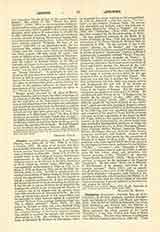

Lesueur, JEAN-FRANCOIS, composer, b. at Drucat-Plessiel, near Abbeville, February 15, 1760; d. at Paris October 6, 1837. He came of an ancient and illustrious family of Picardy, his great uncle being the celebrated painter, Eustache Lesueur. At seven he became a chorister at Abbeville. From 1774 to 1779 he studied music at the College of Amiens, then became music-master at the cathedral of Seez, and later assistant-master at the Church of the Holy Innocents at Paris, where he studied under Abbe Roze. He was appointed music-master at Dijon in 1781, at Le Mans in 1782, at Tours in 1783, and at the Holy Innocents, Paris, in 1784. In 1786 he competed for the musical directorship of Notre-Dame-de-Paris and received the appointment. Allowed by the chapter to install a complete orchestra, he at once proceeded to put in practice his novel ideas concerning sacred music. It was his aim to arouse devotion by an appeal to the imagination, and he so far carried out his theories as to preface one of his masses with an operatic overture; this caused a stir in the musical world. In 1787 came an anonymous attack on his compositions and his methods, to which Lesueur replied in a pamphlet entitled “Expose d’une musique imitative et particuliere chaque solennite” (Paris, 1787). At this period he became an abbe, but never received Holy orders. The chapter of Notre-Dame having reduced the orchestra because of the heavy expense, Lesueur was unable to produce hid masses, and resigned his directorship in 1788. He withdrew to the country home of his friend M. Bochart de Champigny, where he remained four years, working on his compositions. In 1793 he produced a three-act opera, “La Caverne”, at the Theatre Feydeau, Paris. Its success was immediate and brilliant and it was followed at the same theatre by “Paul et Virginie” (January 13, 1794) and “Telemaque” (May, 1796), which latter had been accepted by the Royal Academy of Music.
He was appointed professor in the Ecole de la Garde Nationale, November 21, 1793, and an inspector of instruction at the Conservatoire de Musique from its foundation in 1795. On the rejection of two of his operas, “Ossian, ou lea Bardes” and “La mort d’Adam” (which had been accepted by the Academy), in favor of Catel’s “Semiramis”, Lesueur published anonymously a pamphlet entitled “Projet d’un plan general de l’instruction musicale en France“, in which he violently attacked not only the methods of instruction followed at the Conservatoire, but his rival Catel and Catel’s patron, the director of the Conservatoire. Lesueur’s dismissal followed (September 23, 1802), and the cessation of his salary had brought him to the verge of extreme poverty when he was appointed maitre de chapelle to the First Consul. The musician was now free to produce his “Ossian”; its first performance (July 10, 1804) was a great success and inaugurated the new title of the theatre as Academie Imperiale. He was rewarded with the Cross of the Legion of Honor. For the emperor’s coronation he composed a mass and a Te Deum. He collaborated with Persil’s in his “L’inauguration du temple de la victoire” (January 2, 1807) and “Le Triomphe de Trajan” (October 23, 1807). On March 21, 1809, he produced “La mort d’Adam et son apotheose”, which proved to be lacking in dramatic action. In 1813 Lesueur succeeded Gretry at the Institut, and in the following year was appointed superintendent and composer of the chapel of Louis XVIII, retaining this post until the suppression of the chapel in 1830. On January 1, 1818, he was appointed professor of composition at the Conservatoire, his classes being large and numbering distinguished members, of whom the following gained the prix de Rome: Bourgeois, Ermel, Paris, Guiraud, Berlioz, Prevost, Ambroise Thomas, Elwart, Boulanger, Besozzi, Boisselot (who became Lesueur’s son-in-law), and Gounod. Lesueur wrote the Te Deum and other music for the coronation of Charles X at Reims (May 29, 1825) His other compositions were: three operas which had been accepted by the Opera but were never performed in his lifetime, “Tyrhee”, “Artaxerse”, and “Alexandre A. Baby-lone”; a Christmas mass or oratorio (1826); a solemn mass for four voices, choir, and orchestra; two Passion oratorios (1029); “Rachel“,’ an oratorio; “Super flumina Babylonia” (1833); “Ruth et Booz”, oratorio; a cantata for the marriage of the Emperor Napoleon I. He also wrote “Notice sur la Melopee, la Rhythmopee, et lea grandee caracteres de la musique ancienne” (Paris, 1793); and an unpublished treatise on the music of the Greeks. Lesueur had both originality and genius, and, while it is impossible to rank him with Cherubini and Maul, it is nevertheless true that the French school of the early nineteenth century is greatly indebted to his initiative and passion for his art.
BLANCHE M. KELLY

